Eerie images from watery grave of first submarine
› Angela Pownall
More light has been shed on one of the nation’s greatest maritime mysteries, with the release yesterday of images of the watery grave of Australia’s first submarine, HMAS AE1, which sank in 1914.
For more than a century, the fate of HMAS AE1 and her crew of 35 was unknown until a Federal Government-backed mission found the submarine in December on the sea floor off the Duke of York Islands in PNG’s East New Britain province.
The loss on September 14, 1914, in what was then German New Guinea was the Royal Australian Navy’s first and the first Allied submarine loss in World War I. The latest survey, which has produced the best images yet of HMAS AE1’s resting place, was conducted on Microsoft co-founder Paul Allen’s research vessel the RV Petrel. Experts from Curtin University and the WA Museum were among those aboard to help inspect the submarine with the ship’s remotely operated vehicle fitted with high-definition video and stills cameras.
The RV Petrel diverted to the Duke of York Islands after a series of successful expeditions that located the World War II shipwrecks of US Navy ships the Lexington, Juneau and Helena.
“The AE1 has a special place in Australian maritime history and I’m proud of our partnership with the Australian National Maritime Museum and others that brought an end to the mystery of the AE1’s final resting place,” Mr Allen said.
“For all of us associated with Petrel, we view this work as a means to honour the courage and sacrifice of the crew of the AE1.”
The still images of the shipwreck site will be developed into a detailed 3D digital model using techniques developed by Curtin University and the WA Museum to enable the Find AE1 team and researchers to further examine and understand what happened to it 103 years ago.
A report into HMAS AE1’s discovery last year said the submarine was sunk when it dropped to a depth of more than 100m, well below its operating depth of 30m, causing a crush and a quick end for the crew.
But, speaking to descendants of the crew last year, retired rear-admiral Peter Briggs said critical questions over what happened to the submarine remained unanswered.
He said it was hoped that more “manoeuvred” images and video around the wreck would provide a lot more evidence.

